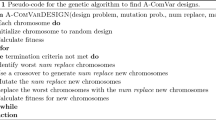Abstract
Traditional foldover designs are obtained by changing the signs of some columns of an initial design. Li and Lin (Technometrics 58:508–512, 2016) proposed to further improve foldover designs by allowing column permutations. To deal with computational challenges in obtaining the optimal foldover with column permutations, we explore some theoretical properties of such designs. Using the indicator function approach, we investigate under what circumstances can a foldover design be improved by doing column permutations. Several types of permutations are found to be particularly effective for this purpose.
Similar content being viewed by others
References
Ai MY, Xu X, Wu CFJ (2010) Optimal blocking and foldover plans for regular two-level designs. Stat Sin 20:183–207
Balakrishnan N, Yang P (2006a) Classification of three-word indicator functions of two-level factorial designs. Ann Inst Stat Math 58:595–608
Balakrishnan N, Yang P (2006b) Connections between the resolutions of general two-level factorial designs. Ann Inst Stat Math 58:609–618
Balakrishnan N, Yang P (2011) De-aliasing effects using semifoldover techniques. J Stat Plan Inference 139:3102–3111
Cheng SW, Ye KQ (2004) Geometric isomorphism and minimum aberration for factorial designs with quantitative factors. Ann Stat 32:2168–2185
Deng LY, Tang B (1999) Generalized resolution and minimum aberration for Plackett–Burman and other non-regular factorial designs. Stat Sin 9:1071–1082
Edwards DJ (2011) Optimal semifoldover plans for two-level orthogonal designs. Technometrics 53:274–284
Errore A, Jones B, Li W, Nachtsheim CJ (2017) Benefits and fast construction of efficient two-level foldover designs. Technometrics 59:48–57
Fontana R, Pistone G, Rogantin MP (2000) Classification of two-level factorial fractions. J Stat Plan Inference 87:149–172
Li H, Mee RW (2002) Better foldover fractions for resolution III \(2^{k-p}\) designs. Technometrics 44:278–283
Li W, Lin DKJ (2003) Optimal foldover plans for two-level fractional factorial designs. Technometrics 45:142–149
Li W, Lin DKJ (2016) A note on foldover of \(2^{k-p}\) designs with column permutations. Technometrics 58:508–512
Li W, Lin DKJ, Ye KQ (2003) Optimal foldover plans for two-level nonregular orthogonal designs. Technometrics 45:347–351
McLeod RG, Brewster JF (2008) Optimal foldover plans for two-level fractional factorial split-plot designs. J Qual Technol 40:227–240
Ou Z, Qin H, Li H (2011) Optimal blocking and foldover plans for nonregular two-level designs. J Stat Plan Inference 141:1635–1645
Pistone G, Wynn HP (1996) Generalised confounding with Grobner bases. Biometrika 83:653–666
Sabbaghi A, Dasgupta T, Wu CFJ (2014) Indicator function and the algebra of the linear-quadratic parameterization. Biometrika 101:351–363
Yang P, Lin CY, Li W (2015) Blocked semifoldovers of two-level orthogonal designs. Metrika 78:529–548
Ye KQ (2003) Indicator function and its application in two-level factorial designs. Ann Stat 31:984–994
Ye KQ, Li W (2003) Some properties of blocked and unblocked foldovers of \(2^{k-p}\) designs. Stat Sin 13:403–408
Acknowledgements
We would like to thank the referees for their time and valuable comments that lead to the great improvement of our manuscript. Dr. Po Yang is supported by Natural Science and Engineering Research Council of Canada.
Author information
Authors and Affiliations
Corresponding author
Ethics declarations
Conflict of interest
The authors declare that they have no conflict of interest.
Rights and permissions
About this article
Cite this article
Yang, P., Li, W. Some properties of foldover designs with column permutations. Metrika 82, 705–717 (2019). https://doi.org/10.1007/s00184-018-0702-z
Received:
Published:
Issue Date:
DOI: https://doi.org/10.1007/s00184-018-0702-z



